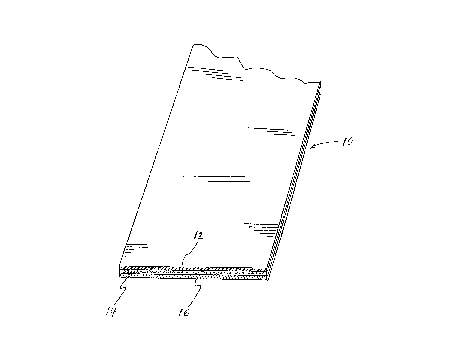Some of the information on this Web page has been provided by external sources. The Government of Canada is not responsible for the accuracy, reliability or currency of the information supplied by external sources. Users wishing to rely upon this information should consult directly with the source of the information. Content provided by external sources is not subject to official languages, privacy and accessibility requirements.
Any discrepancies in the text and image of the Claims and Abstract are due to differing posting times. Text of the Claims and Abstract are posted:
| (12) Patent: | (11) CA 2088619 |
|---|---|
| (54) English Title: | ADHESIVE TAPE FOR OVERCOATING SPLICES IN POLYMER COATED METAL TAPES |
| (54) French Title: | RUBAN ADHESIF POUR ENROBER LES EPISSURES FAITES DANS UN RUBAN METALLIQUE REVETU D'UN POLYMERE |
| Status: | Expired and beyond the Period of Reversal |
| (51) International Patent Classification (IPC): |
|
|---|---|
| (72) Inventors : |
|
| (73) Owners : |
|
| (71) Applicants : |
|
| (74) Agent: | PRIMAK & CO. |
| (74) Associate agent: | |
| (45) Issued: | 1999-08-03 |
| (22) Filed Date: | 1993-02-02 |
| (41) Open to Public Inspection: | 1994-08-03 |
| Examination requested: | 1993-02-02 |
| Availability of licence: | N/A |
| Dedicated to the Public: | N/A |
| (25) Language of filing: | English |
| Patent Cooperation Treaty (PCT): | No |
|---|
| (30) Application Priority Data: | None |
|---|
An adhesive tape is provided for overcoating
splices in polymer coated metal tapes, which comprises a
plastic film that serves as recoating material, a layer of
adhesive applied to one face of this film and covered by a
release sheet which is peeled-off when required to expose
the adhesive tape which is then applied onto the area of
the splice to overcoat the same. The adhesive is
crosslinkable by application of heat and is crosslinked
during a subsequent cable jacketing operation, thereby
forming a strong bond between the non-coated metal tape in
the splice area and the recoating plastic film.
Note: Claims are shown in the official language in which they were submitted.
Note: Descriptions are shown in the official language in which they were submitted.

2024-08-01:As part of the Next Generation Patents (NGP) transition, the Canadian Patents Database (CPD) now contains a more detailed Event History, which replicates the Event Log of our new back-office solution.
Please note that "Inactive:" events refers to events no longer in use in our new back-office solution.
For a clearer understanding of the status of the application/patent presented on this page, the site Disclaimer , as well as the definitions for Patent , Event History , Maintenance Fee and Payment History should be consulted.
| Description | Date |
|---|---|
| Inactive: IPC assigned | 2018-10-16 |
| Inactive: IPC removed | 2018-10-16 |
| Inactive: IPC removed | 2018-10-16 |
| Inactive: First IPC assigned | 2018-10-16 |
| Inactive: IPC assigned | 2018-10-16 |
| Inactive: IPC assigned | 2018-10-16 |
| Inactive: IPC expired | 2018-01-01 |
| Inactive: IPC removed | 2017-12-31 |
| Inactive: IPC from MCD | 2006-03-11 |
| Time Limit for Reversal Expired | 2003-02-03 |
| Letter Sent | 2002-02-04 |
| Letter Sent | 2001-01-18 |
| Grant by Issuance | 1999-08-03 |
| Inactive: Cover page published | 1999-08-02 |
| Pre-grant | 1999-04-28 |
| Inactive: Final fee received | 1999-04-28 |
| Notice of Allowance is Issued | 1999-04-09 |
| Letter Sent | 1999-04-09 |
| Notice of Allowance is Issued | 1999-04-09 |
| Inactive: IPC assigned | 1999-03-29 |
| Inactive: IPC removed | 1999-03-24 |
| Inactive: Approved for allowance (AFA) | 1999-03-13 |
| Amendment Received - Voluntary Amendment | 1998-08-14 |
| Inactive: S.30(2) Rules - Examiner requisition | 1998-05-01 |
| Inactive: Inventor deleted | 1998-04-17 |
| Inactive: Application prosecuted on TS as of Log entry date | 1998-04-16 |
| Inactive: Status info is complete as of Log entry date | 1998-04-16 |
| Application Published (Open to Public Inspection) | 1994-08-03 |
| Request for Examination Requirements Determined Compliant | 1993-02-02 |
| All Requirements for Examination Determined Compliant | 1993-02-02 |
There is no abandonment history.
The last payment was received on 1999-01-21
Note : If the full payment has not been received on or before the date indicated, a further fee may be required which may be one of the following
Patent fees are adjusted on the 1st of January every year. The amounts above are the current amounts if received by December 31 of the current year.
Please refer to the CIPO
Patent Fees
web page to see all current fee amounts.
| Fee Type | Anniversary Year | Due Date | Paid Date |
|---|---|---|---|
| Request for examination - standard | 1993-02-02 | ||
| Registration of a document | 1997-04-01 | ||
| MF (application, 5th anniv.) - standard | 05 | 1998-02-02 | 1998-01-22 |
| MF (application, 6th anniv.) - standard | 06 | 1999-02-02 | 1999-01-21 |
| Final fee - standard | 1999-04-28 | ||
| MF (patent, 7th anniv.) - standard | 2000-02-02 | 2000-01-14 | |
| Registration of a document | 2000-12-06 | ||
| MF (patent, 8th anniv.) - standard | 2001-02-02 | 2001-01-15 |
Note: Records showing the ownership history in alphabetical order.
| Current Owners on Record |
|---|
| ALCATEL CANADA INC. |
| ALCATEL CANADA INC. |
| NEXANS CANADA INC. |
| Past Owners on Record |
|---|
| HAL G. S. AITKEN |
| RICHARD W. DEMIANYK |